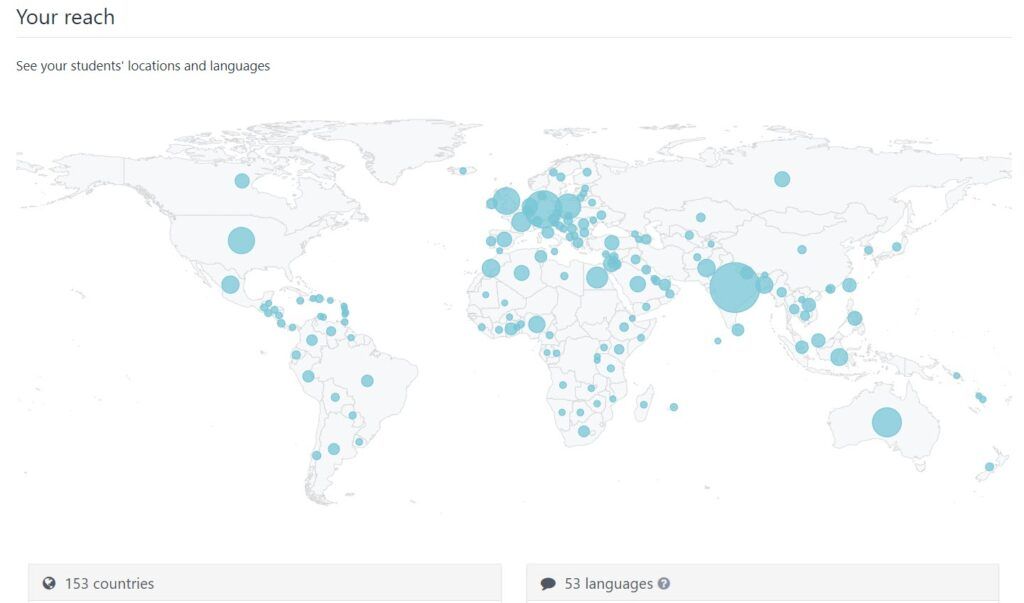So, say you want to create an online training course. Or it can be that you have already created it. In which case, congratulations, well done for doing it. I know the amount of work that goes into it.
The next thing you might wonder is how to promote and sell your course, how to reach your audience and so on. What are the platforms available and what is the best one for you?
What I’m about to share in this article is based on my own experience, which although not extensive since I’ve only been creating online courses this year, it’s what’s been working for me in terms of growth and reaching a worldwide audience. In other words, take away what you think might work or might be useful to you.
KARTRA:
When I initially created my online courses, I went for Kartra as the hosting platform.
Why Kartra? Because I was already using it for everything else. I use it to store all my contacts, to send email campaigns, to create video funnels, different landing pages with download options, to sell other online services, run my calendar appointments, etc.
Kartra also gives you the functionality to create Membership Areas, where you can upload all of your courses’ content while customising the training experience for your clients. It automatically generates login details per user, enables payments and more. In my opinion, it’s a great tool, especially for small businesses.
If you are getting started with Kartra and need some help, feel free to book a virtual coffee with either my brother or me, we will be very happy to assist you (find links at the bottom of this article).
UDEMY:
With Kartra I initially grew my community of students to about 100 people and of course, I wanted more, so what to do next?
I took a look at the different online learning platforms and I felt a bit overwhelmed because I didn’t know which one to go for. The next step was to check out the most popular ones. This is when I decided to try Udemy, where I initially uploaded 3 different training courses:
I’m writing this blog on December 23rd 2020 and my Udemy profile shows over 25K students spread across 153 countries.
Thanks to Udemy I’ve managed to reach an audience I could’ve never dreamt of 2-3 months ago. For more information about how to succeed with Udemy, check out this blog:
Grow your students’ community on Udemy
SKILLSHARE:
After Udemy, I began looking at Skillshare, which by the way has a slightly different business model. With Skillshare you pay a monthly membership that gives you access to thousands of classes for creative and curious people, on topics including illustration, design, photography, video, freelancing, and more. On Skillshare, millions of members come together to find inspiration and take the next step in their creative journey. As a teacher, you get paid based on the premium minutes students watch.
In Udemy you have quizzes, practise tests and assignments for your students to test their knowledge. In Skillshare everything revolves around the project, which I find very cool. Every student is supposed to submit their project after finishing your class.
One of Skillshare’s values is to learn by doing, which is why all classes include a class project. Class projects help students practice their new skills while creating something new and exciting. Bear this in mind when creating your class.
OTHERS:
Apart from Udemy and Skillshare, I would invite you to try Teachable and Thinkific. There are many more, of course, and I can foresee new ones emerging as the online learning market continues to grow rapidly.
If you still don’t know where to begin, let me share this with you. About a month ago I ran a poll on LinkedIn asking my over 8K connections what their preferred learning platform was and 63% voted for Udemy. Hope this helps.
For me, Udemy has been like the springboard into the online learning world. My success here is attracting more students, coaching and training opportunities and also new e-learning platforms that would like to host my current and new content.
FINAL THOUGHTS:
Well, out of all of the things I mentioned, go and test. Try a platform, try another one, tweak your courses to suit each platform and always remain open to feedback from your audience. In the end, it’s your audience (the market) who will tell you how good your content is and it’s your responsibility to listen and pivot accordingly to satisfy their demands.
Say, for instance, you expected five stars but only got three, instead of getting upset, do the opposite, appreciate their feedback, there’s an opportunity to learn. Here is a powerful question you can ask: What can I change for you to give me a 5-star rating?
It’s amazing what you can take away when you ask questions and really listen.
If you want further insights, watch the below video, where I openly share my current experience with the various e-learning platforms.
I hope you enjoyed this article. As promised, find various links below:
- Kartra: https://josemindsetcoach.krtra.com/t/DwE2I8A3x6lF
- My Membership Area on Kartra: https://www.worldclass-communicator.com
- Udemy: https://www.udemy.com/
- My Udemy Profile: https://www.udemy.com/user/jose-ucar/
- Skillshare: https://www.skillshare.com/home
- Teachable: https://teachable.com/
- Thinkific: https://www.thinkific.com/
- Book a virtual coffee with Jose: https://josemindsetcoach.kartra.com/calendar/Coaching-with-Jose
Wish you great success.
All the best,
Jose Ucar
Want to create more engaging videos for your courses? Check out this blog: Are your Videos Communicating your Message?


